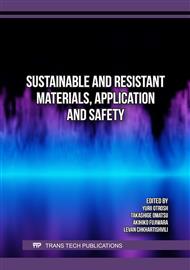[1]
Philippine Department of Energy, 2023. Philippine Energy Plan 2023-2050.
Google Scholar
[2]
Elauria, J.C., Castro, M.L.Y., Elauria, M.M., Bhattacharya, S.C., Salam, P.A., 2005. Assessment of sustainable energy potential of non-plantation biomass resources in the Philippines. Biomass and Bioenergy 29, 191-198
DOI: 10.1016/j.biombioe.2005.03.007
Google Scholar
[3]
Daza Montaño, C., Van Dam, J.E.G., 2021. Potential of Bamboo for Renewable Energy: Main Issues and Technology Options. International Bamboo and Rattan Organisation.
Google Scholar
[4]
Tang, X. et al., 2018. Carbon pools in China's terrestrial ecosystems: New estimates based on an intensive field survey. Proceedings of the National Academy of Sciences 115, 4021–4026
DOI: 10.1073/pnas.1700291115
Google Scholar
[5]
Guarin, L.P., Bordado, E.B., 2021. Bamboo Technoguide. Regional Agriculture and Fisheries Information Section, Department of Agriculture Regional Field Office No. 5.
Google Scholar
[6]
Roxas, C.A., 2012. Handbook on Erect Bamboo Species Found in the Philippines. Ecosystems Research and Development Bureau, Department of Environment and Natural Resources.
Google Scholar
[7]
Razal, R.A., Dolom, P.C., Palacpac, A.B., Villanueva, Ma.M.B., Sofronio C. Camacho, Marina B. Alipon, Rosario B. Bantayan, Stanley C. Malab, 2012. Mainstreaming Engineered-Bamboo products for construction and furniture, College of Forestry and Natural Resources. PCAARRD.
Google Scholar
[8]
Dahlquist, E. Biomass as energy source: resources, systems and applications, 2013. Choice Reviews Online 51, 51–2104
DOI: 10.5860/choice.51-2104
Google Scholar
[9]
Anokye, R., Kalong, R.M., Bakar, E.S., Ratnasingam, J., Jawaid, M., Awang, K., 2014. Variations in Moisture Content Affect the Shrinkage of Gigantochloa scortechinii and Bambusa vulgaris at Different Heights of the Bamboo Culm. BioResources 9
DOI: 10.15376/biores.9.4.7484-7493
Google Scholar
[10]
Hughes, W.E.M., Larson, E.D., 1998. Effect of fuel moisture content on Biomass-IGCC performance. Journal of Engineering for Gas Turbines and Power 120, 455–459
DOI: 10.1115/1.2818166
Google Scholar
[11]
Motta, IL, Miranda, NT, Filho, RM & Maciel, MRW., 2018. "Biomass gasification in fluidized beds: A review of biomass moisture content and operating pressure effects," Renewable and Sustainable Energy Reviews, 94998–1023.
DOI: 10.1016/j.rser.2018.06.042
Google Scholar
[12]
Wahab, R., Mustapa, M.T., Sulaiman, O., Mohamed, A., Hassan, A., Khalid, I., 2010. Anatomical and physical properties of cultivated two- and four-year-old bambusa vulgaris. Sains Malaysiana 39, 571–579.
Google Scholar
[13]
Singh, B., Dessalegn, Y., Wakjira, M.W., Girma, C., Rajhi, A.A., Duhduh, A.A., 2023. Characterization of bamboo culm as potential fibre for composite development. Materials 16, 5196
DOI: 10.3390/ma16145196
Google Scholar
[14]
García, R., Pizarro, C., Lavín, A.G., Bueno, J.L., 2013. Biomass proximate analysis using thermogravimetry. Bioresource Technology 139, 1–4
DOI: 10.1016/j.biortech.2013.03.197
Google Scholar
[15]
Susanto, B., Tosuli, Y.T., Adnan, N., Cahyadi, N., Nami, H., Surjosatyo, A., Alandro, D., Nugroho, A.D., Rashyid, M.I., Muflikhun, M.A., 2024. Characterization of sago tree parts from Sentani, Papua, Indonesia for biomass energy utilization. Heliyon 10, e23993
DOI: 10.1016/j.heliyon.2024.e23993
Google Scholar
[16]
George, O. S., Dennison, M. S., & Yusuf, A. A. (2023). Characterization and energy recovery from biomass wastes. Sustainable Energy Technologies and Assessments, 58, 103346.
DOI: 10.1016/j.seta.2023.103346
Google Scholar
[17]
Abioye, K.J., Harun, N.Y., Sufian, S., Yusuf, M., Jagaba, A.H., Ekeoma, B.C., Kamyab, H., Sikiru, S., Waqas, S., Ibrahim, H., 2023. A review of biomass ash related problems: Mechanism, solution, and outlook. Journal of the Energy Institute 112, 101490
DOI: 10.1016/j.joei.2023.101490
Google Scholar
[18]
Rajvanshi, A., Nimbkar agricultural research institute, 1986. Biomass gasification, alternative energy in agriculture. Energy Sources.
Google Scholar
[19]
Watkins, D, Nuruddin, Md, Hosur, M, Tcherbi-Narteh, A & Jeelani, S., 2014. "Extraction and characterization of lignin from different biomass resources," Journal of Materials Research and Technology, 4(1):26–32.
DOI: 10.1016/j.jmrt.2014.10.009
Google Scholar
[20]
Demirbaş, A., 2003. Relationships between lignin contents and fixed carbon contents of biomass samples. Energy Conversion and Management, 44(9), 1481–1486
DOI: 10.1016/s0196-8904(02)00168-1
Google Scholar
[21]
Shibata, M, Varman, M, Tono, Y, Miyafuji, H & Saka, S., 2008. "Characterization in Chemical Composition of the Oil Palm (Elaeis guineensis)," Journal of the Japan Institute of Energy, 87 (5): 383–388.
DOI: 10.3775/jie.87.383
Google Scholar
[22]
Raji, S., Sarode, D.D., 2018. Study of suitability of biomass wastes as sustainable fuel, in: Lecture Notes in Civil Engineering. p.562–568
DOI: 10.1007/978-3-030-02707-0_64
Google Scholar


